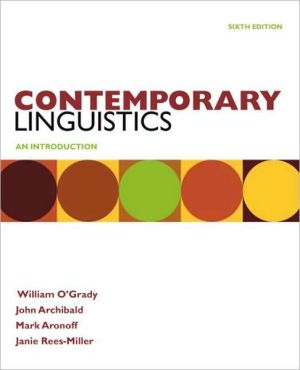Contemporary Linguistics: An Introduction
Contemporary Linguistics is one of the most comprehensive introduction to the fundamentals of linguistics, balancing engaging aspects of language study with solid coverage of the basics. Up-to-date scholarship, a direct approach, and a lucid writing style makes it appealing to instructors and beginning students alike and a resource that many students continue to use beyond the classroom.
Search in google:
Contemporary Linguistics is one of the most comprehensive introduction to the fundamentals of linguistics, balancing engaging aspects of language study with solid coverage of the basics. Up-to-date scholarship, a direct approach, and a lucid writing style makes it appealing to instructors and beginning students alike and a resource that many students continue to use beyond the classroom.
Preface vPreface to the First Edition ixList of Technical Abbreviations xxiiiLanguage Matters Boxes xxv1 Language: A Preview 11 Specialization for Language 22 A Creative System 33 Grammar and Linguistic Competence 63.1 Generality: All Languages Have a Grammar 73.2 Parity: All Grammers Are Equal 83.3 Universality: Grammars Are Alike in Basic Ways 93.4 Mutability: Grammars Change over Time 103.5 Inaccessibility: Grammatical Knowledge Is Subconscious 11Summing Up 12Key Terms 13Recommended Reading 13Exercises 132 Phonetics: The Sounds of Language 151 Phonetic Transcription 161.1 Units of Representation 171.2 Segments 182 The Sound-Producing System 192.1 Glottal States 193 Sound Classes 213.1 Vowels, Consonants, and Glides (Syllabic and Nonsyllabic Elements) 214 Consonant Articulation 224.1 The Tongue 224.2 Places of Articulation 235 Manners of Articulation 255.1 Oral versus Nasal Phones 255.2 Stops 255.3 Fricatives 265.4 Affricates 285.5 Voice Lag and Aspiration 285.6 Liquids 315.7 Syllabic Liquids and Nasals 325.8 Glides 336 Vowels 346.1 Simple Vowels and Diphthongs 346.2 Basic Parameters for Describing Vowels 366.3 Tense and Lax Vowels 377 Phonetic Transcription of American English Consonants and Vowels 388 Suprasegmentals 408.1 Pitch: Tone and Intonation 408.2 Length 448.3 Stress 459 Speech Production 469.1 Coarticulation 469.2 Articulatory Processes 469.3 Some Common Articulatory Processes 4710 Other Vowels and Consonants 51Summing Up 53Key Terms 53Recommended Reading 55Exercises 553Phonology: The Function and Patterning of Sounds 591 Segments in Contrast 611.1 Minimal Pairs 611.2 Languages-Specific Contrasts 642 Phonetically Conditioned Variation: Phonemes and Allophones 652.1 Complementary Distribution 652.2 Phonemes and Allophones 672.3 Classes and Generalization in Phonology 702.4 English Mid Vowels and Glides 722.5 Language-Specific Patterns 733 Phonetic and Phonemic Transcription 743.1 Phonetic and Phonemic Inventories 764 Above the Segment: Syllables 774.1 Defining the Syllable 774.2 Onset Constraints and Phonotactics 794.3 Accidental and Systematic Gaps 804.4 Setting Up Syllables 824.5 Syllabic Phonology 845 Features 865.1 Why We Use Features 875.2 Feature Representations 916 Derivations and Rules 976.1 Derivations 986.2 Rule Application 996.3 The Form and Notation of Rules 1006.4 Processes and Rules: A Last Word 103Summing Up 103Key Terms 103Recommended Reading 104Appendix: Hints for Solving Phonology Problems 105Exercises 1064 Morphology: The Analysis of Word Structure 1151 Words and Word Structure 1161.1 Morphemes 1171.2 Analyzing Word Structure 1182 Derivation 1222.1 Some English Derivational Affixes 1232.2 Two Classes of Derivational Affixes 1263 Compounding 1273.1 Properties of Compounds 1293.2 Endocentric and Exocentric Compounds 1293.3 Compounds in Other Languages 1304 Inflection 1314.1 Inflection in English 1314.2 Inflection versus Derivation 1324.3 Other Inflectional Phenomena 1345 Other Morphological Phenomena 1355.1 Processes Primarily Related to Inflection 1355.2 Other Processes 1386 Morphophonemics 143Summing Up 144Key Terms 144Recommended Reading 145Appendix: How to Identify Morphemes in Unfamiliar Languages 145Exercises 1475 Syntax: The Analysis of Sentence Structure 1551 Categories and Structure 1571.1 Categories of Words 1571.2 Phrase Structure 1601.3 Sentences 1651.4 Tests for Phrase Structure 1672 Complement Options 1682.1 Complement Options for Verbs 1682.2 Complement Options for Other Categories 1692.3 Complement Clauses 1703 Move 1723.1 Yes-No Questions 1723.2 Deep Structure and Surface Structure 1763.3 Do Insertion 1773.4 Wh Movement 1784 Universal Grammar and Parametric Variation 1834.1 Verb Raising 1835 Some Additional Structures 1875.1 Coordination 1875.2 Modifiers 1895.3 Passives 190Summing Up 193Key Terms 193Recommended Reading 194Appendix: How to Build Tree Structures 194Exercises 1996 Semantics: The Analysis of Meaning 2031 The Nature of Meaning 2041.1 Semantic Relations among Words 2041.2 Semantic Relations Involving Sentences 2071.3 What Is Meaning? 2082 The Conceptual System 2132.1 Fuzzy Concepts 2132.2 Metaphor 2142.3 The Lexicalization of Concepts 2162.4 Grammatical Concepts 2193 Syntax and Sentence Interpretation 2213.1 Constructional Meaning 2213.2 Structural Ambiguity 2233.3 Thematic Roles 2243.4 The Interpretation of Pronouns 2284 Other Factors in Sentence Interpretation 2324.1 The Role of Beliefs and Attitudes 2324.2 Setting 2334.3 Discourse 2344.4 Grice's Conversational Maxims 236Summing Up 238Key Terms 238Recommended Reading 240Exercises 2407 Historical Linguistics: The Study of Language Change 2451 The Nature of Language Change 2461.1 Systematicity of Language Change 2471.2 Causes of Language Change 2472 Sound Change 2492.1 Sequential Change 2492.2 Segmental Change 2552.3 Auditorily Based Change 2562.4 Phonetic versus Phonological Change 2572.5 Explaining Phonological Shift 2593 Morphological Change 2593.1 Addition of Affixes 2593.2 Loss of Affixes 2603.3 From Synthetic to Analytic to Synthetic 2613.4 Analogy 2623.5 Reanalysis 2624 Syntactic Change 2634.1 Word Order 2634.2 Inversion in the History of English 2665 Lexical and Semantic Change 2665.1 Addition of Lexical Items 2665.2 Loss of Lexical Items 2715.3 Semantic Change 2726 The Spread of Change 2756.1 Diffusion through the Language 2756.2 Spread through the Population 2777 Language Reconstruction 2787.1 Comparative Reconstruction 2787.2 Techniques of Reconstruction 2797.3 The Discovery of Indo-European 2858 Language Change and Naturalness 287Summing Up 288Key Terms 289Recommended Reading 290Exercises 2918 The Classification of Languages 2971 Some Preliminaries 2971.1 Dialect and Language 2981.2 Types of Classification 3012 Typological Classification 3022.1 Phonology 3032.2 Morphology 3102.3 Syntax 3132.4 Explaining Universals 3163 Genetic Classification 3193.1 The Indo-European Family 3203.2 Some Other Families 3253.3 Language Phyla 325Summing Up 328Key Terms 328Recommended Reading 328Exercises 3299 Indigenous Languages of North America 3331 Origin and Classification 3341.1 Ultimate Origins 3341.2 Historical Relationships in North America 3352 Phonetics and Phonology 3372.1 Velar, Uvular, and Pharyngeal Articulations 3372.2 Lateral Fricatives 3372.3 Glottalized Stops and Affricates (Ejectives) 3382.4 Vowels and Suprasegmental Features 3382.5 Sounds Not Frequently Found 3393 Morphology and Syntax 3393.1 The Structure of Words 3393.2 Grammatical Categories 3423.3 Pronominal Systems 3453.4 Noun Classification 3464 The Future of Indigenous North American Languages 348Summing Up 350Key Terms 350Recommended Reading 35010 First Language Acquisition 3511 The Study of Language Acquisition 3521.1 Methods 3522 Phonological Development 3562.1 Babbling 3562.2 Developmental Order 3572.3 Early Phonetic Processes 3583 Vocabulary Development 3613.1 Strategies for Acquiring Word Meaning 3623.2 Meaning Errors 3634 Morphological Development 3674.1 Overgeneralization 3674.2 A Developmental Sequence 3684.3 Word Formation Processes 3705 Syntactic Development 3715.1 The One-Word Stage 3715.2 The Two-Word Stage 3725.3 The Telegraphic Stage 3735.4 Later Development 3745.5 The Interpretation of Sentence Structure 3766 What Makes Language Acquisition Possible? 3786.1 The Role of Adult Speech 3786.2 The Role of Feedback 3806.3 The Role of Cognitive Development 3816.4 The Role of Inborn Knowledge 3826.5 Is There a Critical Period? 384Summing Up 385Key Terms 385Recommended Reading 386Exercises 38611 Second Language Acquisition 3911 The Study of Second Language Acquisition 3921.1 The Role of the First Language 3921.2 The Nature of an Interlanguage 3931.3 The Final State 3941.4 Variation in Performance 3962 Interlanguage Grammars 3982.1 L2 Phonology 3982.2 L2 Syntax 4052.3 L2 Morphology 4082.4 Morphology and Syntax 4113 Factors Affecting SLA 4133.1 Age 4133.2 Individual Differences 4144 The L2 Classroom 4184.1 Modified Input 4184.2 Modified Interaction 4194.3 Focus on Form 4194.4 Education in a Bilingual Environment 421Summing Up 425Key Terms 425Recommended Reading 426Exercises 42712 Psycholinguistics: The Study of Language Processing 4291 Methods of Psycholinguistic Research 4301.1 Slips of the Tongue 4301.2 Experimental Methods: Words in the Mind 4321.3 Experimental Methods: Sentence Processing 4361.4 Brain Activity: Even-Related Potentials 4381.5 Language Corpora and Databases in Psycholinguistic Research 4402 Language Processing and Linguistics 4412.1 Phonetics and Phonology 4412.2 Morphological Processing 4432.3 Syntax 4473 Putting It All Together: Psycholinguistic Modeling 4503.1 The Use of Metaphors in Psycholinguistic Modeling 4513.2 Which Model Is Rights? 454Summing Up 455Key Terms 456Recommended Reading 457Exercises 45713 Brain and Language 4591 The Human Brain 4601.1 The Cerebral Cortex 4601.2 The Cerebral Hemispheres 4611.3 The Lobes of the Cortex 4632 Investigating the Brain 4642.1 Autopsy Studies 4642.2 Images of the Living Brain 4662.3 Learning from Hemisphere Connections and Disconnections 4693 Aphasia 4713.1 Nonfluent Aphasia 4713.2 Fluent Aphasia 4744 Acquired Dyslexia and Dysgraphia 4754.1 Reading and Writing Disturbances in Aphasia 4754.2 Acquired Dyslexia as the Dominant Language Deficit 4765 Linguistic Theory and Aphasia 4775.1 Features, Rules, and Underlying Forms 4775.2 Agrammatism 4785.3 Function Words 4785.4 The Loss of Syntactic Competence 4795.5 Agrammatism in Other Languages 4795.6 Language in the Brain: What's Where? 480Summing Up 482Key Terms 482Recommended Reading 483Exercises 48314 Language In Social Contexts 4851 Language Variation and Social Distinctions 4872 Place 4892.1 Regional Variation in Lexical Items 4922.2 Regional Variation in Phonology 4932.3 Regional Differences in Morphology and Syntax 4943 Time 4944 Isolation 4974.1 Physical Isolation: The Case of Smith Island 4974.2 Linguistic Isolation: The Case of Quebec French 4984.3 Social Isolation: The Case of Urban African American English 4995 Contact 5005.1 Code-Switching and Borrowing 5005.2 Contact Languages: Mixed Languages, Lingura Francas, Pidgins, and Creoles 5026 Distinctions within a Community: Class, Ethnicity, and Gender 5076.1 Class 5076.2 Ethnicity: The Case of African American English 5086.3 Gender 5126.4 Situation-Specific Factors 5137 Social Interaction and Language 5147.1 Ethnography of Communication 5147.2 Solidarity and Power 5168 How Societies Deal with Language 518Summing Up 522Key Terms 522Recommended Reading 524Exercises 52415 Natural Sign Languages 5271 Phonology 5281.1 Formational Elements 5291.2 Combining Formational Elements 5301.3 Prosody 5302 Morphology 5332.1 Word Formation 5332.2 Verb Agreement 5342.3 Classifier Constructions 5353 Syntax 5373.1 Recursion 5373.2 Word Order 5393.3 Sign Language and Universal Grammar 5404 Language as an Art Form: Sign Language Poetry 5415 New Sign Languages 542Summing Up 543Key Terms 543Recommended Reading 54316 Writing and Language 5451 Types of Writing 5461.1 Logographic Writing 5461.2 Phonographic Writing 5462 The Early History of Writing 5472.1 Prewriting 5472.2 Pictograms 5483 The Development of Writing 5493.1 Rebuses 5503.2 Toward Syllabic Writing 5503.3 Another Middle Eastern Writing System: Hieroglyphs 5513.4 The Emergence of Alphabets 5524 Some Non-European Writing Systems 5554.1 Chinese Writing 5554.2 Japanese Writing 5574.3 Korean Writing 5594.4 Cherokee Writing 5605 English Orthography 5605.1 Irregularities 5615.2 Obstacles to Reform 5636 Writing and Reading 564Summing Up 565Key Terms 566Recommended Reading 566Exercises 56717 Computational Linguistics 5691 Computational Phonetics and Phonology 5721.1 The Talking Machine: Speech Synthesis 5721.2 Speech Recognition 5762 Computational Morphology 5772.1 Morphological Processes 5772.2 Some Problems in Computational Morphology 5803 Computational Syntax 5813.1 Data and Resources 5823.2 Natural Language Analysis 5833.3 Natural Language Generation 5863.4 The Role of Syntax and Semantics 5874 Computational Lexicography 5875 Computational Semantics 5926 Pragmatics 5956.1 Reference Resolution 5956.2 Discourse Markers 5966.3 Spoken Dialogue 5967 Applications of Computational Linguistics 5977.1 Indexing and Concordances 5987.2 Question Answering 5997.3 Automatic Summarization 6007.4 Machine Translation 6017.5 Spoken-Dialogue Systems 603Summing Up 604Key Terms 605Recommended Reading 606Exercises 60618 Animal Communication [Online Only at bedfordstmartins.com/linguistics]Glossary 609Sources 643Language Index 665Index 674








